
95% of researchers rate our articles as excellent or good
Learn more about the work of our research integrity team to safeguard the quality of each article we publish.
Find out more
ORIGINAL RESEARCH article
Front. Educ. , 05 February 2024
Sec. Language, Culture and Diversity
Volume 9 - 2024 | https://doi.org/10.3389/feduc.2024.1245983
Introduction: This study delves into the reality and challenges associated with teaching Saudi Arabian Sign Language (SASL) to hearing students within the context of regular schools.
Methods: A descriptive survey methodology was employed, utilizing a researcher-developed questionnaire. The sample comprised 148 participants, including 94 male and 54 female fifth- and sixth-grade students from Alshams Private School in Riyadh, Saudi Arabia.
Results: The investigation unveiled various obstacles in SASL instruction, encompassing the absence of Deaf sign language teachers, limited availability of diverse levels or courses for sign language education, occasional student embarrassment, and challenges related to the learning environment and resources. Gender-based differences were observed, with female students exhibiting a more positive outlook on the feasibility of SASL instruction. However, no gender-based distinctions were evident concerning perceived obstacles or overall questionnaire responses. Additionally, no significant differences emerged between fifth- and sixth-grade students in their perceptions of obstacles or questionnaire responses.
Discussion: The findings offer valuable insights into the challenges and student perceptions associated with SASL instruction in Saudi Arabian schools. Notably, the study provides a foundation for further research and potential improvements in sign language education.
Given the increasing number of schools teaching sign language, there are a number of growing opportunities for students to learn sign language to fulfill language requirements. ASL has gained popularity as a foreign or general language, with a significant rise in enrollment in ASL classes in high schools, colleges, and universities over the past two decades (Rosen, 2010). Sign languages are also taught in universities worldwide, including in the United Kingdom, New Zealand, Italy, Germany, and Finland. In the United States, more than 210 universities and colleges offer sign language courses, making it the third most popular modern language (Pirone et al., 2023).
Sign language professionals, including program coordinators, faculty, and teaching assistants, play a crucial role in imparting sign language content and practices, ensuring the quality of sign language education and offering professional support. This focus emphasizes the importance of learning sign language in various educational institutions (Quinto-Pozos, 2011).
The study of sign language linguistics and the presence of deaf and hard-of-hearing students in public schools, as well as governmental recognition of sign languages as true languages, have contributed to its inclusion in educational settings (Rosen, 2008, p. 10). Rosen emphasizes the various aspects of teaching sign language to hearing individuals, emphasizing the importance of early exposure, immersive environments, and inclusive educational practices (Rosen, 2010).
Several Arab countries, including the Kingdom of Saudi Arabia (KSA), have taken notable steps in teaching sign language to hearing individuals. In the Alshams Private School, established in 2007, and the Prince Sattam bin Abdulaziz University in Al-Kharj, teaching Saudi Arabian Sign Language (SASL) as an optional course for hearing university students was approved in 2019, and significant progress has been made (Alamri, 2019, p. 35). It’s important to note that SASL, while recognized within the Deaf community and by those interested in the field, is not simply a direct translation of spoken languages such as Arabic. SASL has its own unique grammar, syntax, and vocabulary. While it does include fingerspelling as a component of the language, it may not always have specific corresponding signs for certain words (Alamri, 2017, p. 76; Richardson, 2017, p. 45).
Saudi Deaf culture is a vibrant and essential aspect of the Deaf community in Saudi Arabia, contributing to the learning and teaching of Saudi Arabian Sign Language (SASL). Deaf culture in Saudi Arabia is deeply rooted in the history of Deaf education, the development of SASL, and the efforts of various organizations and individuals dedicated to supporting the Deaf community. Saudi Deaf culture fosters a sense of identity and community among Deaf individuals, providing a shared language and a unique cultural perspective (Alsuraisri and Alkhudair, 2019, p. 182). This culture plays a significant role in supporting the learning and teaching of SASL by creating a strong sense of belonging and shared experiences among Deaf students. It also serves as a source of pride and empowerment for Deaf individuals, encouraging them to embrace and actively participate in the ongoing development and preservation of SASL (Alrayes, 2007, p. 22).
Saudi Arabian Sign Language (SASL) plays a crucial role in helping students learn other academic content, including vocabulary and content memorization. By providing a visual and spatial language for communication, SASL enhances students’ understanding and retention of academic materials (Alamri, 2017, p. 12). When students use sign language to express and comprehend complex concepts, it engages both their visual and motor skills, reinforcing their memory and comprehension. SASL can be particularly beneficial in teaching vocabulary, as signs often represent the meaning of words or concepts, making it easier for students to associate and remember new terms (Rosen, 2010, p. 32).
Several agencies, such as clubs for the deaf, the Ministry of Education, the Ministry of Labor and Social Development, the Saudi Committee for Sign Language Experts and Interpreters, and the Ministry of Culture and Information, have played a role in the development of SASL (Alrayes, 2007, p. 14; Alamri, 2009, p. 26; Alrayes and Alamri, 2014, p. 43). The Human Development Fund also provides services to deaf individuals in SASL, including the provision of sign language interpreters in government and private institutions during employment interviews and meetings (Saudi Human Resources Development Fund, 2017, p. 4). Thus, the use of sign language in communication between deaf and hearing individuals leads to an increase in opportunities for the development of harmony during deaf and hearing interactions.
The use of sign language fosters better understanding, empathy, and mutual respect between deaf and hearing individuals, allowing more integrations of deaf individuals into society. Therefore, sign language teachers need to master sign linguistics, to identify the appropriate vocabulary and grammatical structures during lesson preparation. A critical component of sign linguistics is the use of facial expressions, or non-manual markers in sign language linguistics, to clarify the meaning. One aid for L2/Ln learners is an electronic sign language dictionary, which helps to speed up sign language users’ sign vocabulary from the dictionary (Arab Technical News Portal, 2015, p. 1).
Culture plays a significant role in L2/Ln sign language pedagogy. Clark and Lee (2018) argue that to improve teaching methods, teachers should be aware of the cultural differences within deaf and hearing cultures. Other studies have examined sign language education on a global scale. Pirone et al. (2023) found that although there is a growing demand for ASL education, several barriers remain, including a lack of qualified teachers and limited resources for sign language curriculums. This challenge is further compounded by the observation that many ASL professionals are not faculty members; rather, they are primarily tasked with teaching to meet the soaring demand for ASL classes in their institutions (Robinson and Henner, 2018). Importantly, a significant number of these instructors lack proper training in conducting evidence-based research to enhance the quality of ASL education, particularly for learners using ASL as a second (L2) or additional language (Ln) (Quinto-Pozos, 2011; Rosen, 2019).
Despite the growing interest in teaching sign language to hearing students in regular schools, there is still a gap in the literature when it comes to the reality and obstacles of teaching SASL specifically. While some studies have explored sign language pedagogy in other contexts and languages, such as ASL and British Sign Language, these findings may not necessarily apply to SASL due to cultural and linguistic differences. Therefore, it is important to examine the existing research on sign language pedagogy and adapt it to the Saudi Arabian context. Moreover, building on the findings of previous studies helped to inform the current study, guiding its research design and methodology, and can contribute to the development of effective strategies for teaching sign language to hearing students in regular schools in the KSA. Ultimately, such strategies can improve the educational experiences and integration of deaf students at various stages of their education (Abdulrahman, 2017).
Certain countries, led by the KSA, decided through individual or institutional efforts to teach sign language to hearing students who are not fluent in sign language, so that these students could communicate with their deaf peers in sign language. In addition, the Ministry of Education decided to include SASL in the general education curriculum within the areas of family education and life skills (Ministry of Education, 2022). In 2019, Prince Sattam bin Abdulaziz University included SASL as an optional course for all students.
Since 2007, Alshams Private School has taught SASL to hearing students in primary education. This prompted the researcher to conduct the current study to find out the reality and obstacles of teaching SASL to hearing students in regular schools, based on the case study of Alshams Private School. Alshams Private School is the only school in the KSA to have adopted the teaching of SASL as a foreign language course.
This study aims to make a scientific contribution by examining the process of teaching SASL to male and female students with “typical hearing” in regular schools. The findings reveal the reality of teaching sign language in general education schools in the KSA, as well as identifying the obstacles to teaching it. The research questions are as follows:
1. What is the reality of teaching SASL to hearing students?
2. What are the obstacles to teaching SASL to hearing students?
3. Are there statistically significant differences in the mean responses of male and female students concerning the reality and obstacles of teaching SASL, considering the variables of gender and grade?
The study employs a descriptive methodology to examine the phenomenon in its natural setting, aiming to express it quantitatively. This approach elucidates the magnitude of the phenomenon and its correlations with other phenomena. It serves to comprehensively describe the phenomenon and clarify its characteristics. The choice of using a questionnaire aligns with the descriptive nature of the study, enabling the collection of quantitative data to analyze and illustrate the phenomenon accurately.
The study sample consisted of a total of 148 students (94 males and 54 females), with 65 in the fifth grade (40 males and 25 females) and 83 in the sixth grade (54 males and 29 females) from Alshams Private School in Riyadh, Saudi Arabia. The study took place in a single school, but the students were divided into separate departments based on gender. Each department had its own teacher, with female students being taught by a female teacher and male students by a male teacher. However, both departments were under the same administration and adhered to the same rules and regulations.
Alshams Private School was selected as the research site due to its unique feature of offering sign language education to hearing students, making it the only school in the KSA that provides such instruction. This provided an ideal setting for investigating the reality and obstacles of teaching SASL to hearing students in regular schools.
Individuals in the fifth grade of primary school accounted for 43.9% of the study population, with male students comprising 61.5% (40 out of 65) and female students making up 38.5% (25 out of 65) of this grade level. Similarly, individuals in the sixth grade of primary school represented 56.1% of the study population, with male students accounting for 65.1% (54 out of 83) and female students constituting 34.9% (29 out of 83) of this grade level.
Data collection took place within the school premises, and the researcher worked closely with the teachers and students. Ethical considerations were taken into account, ensuring informed consent and confidentiality of participant information.
A questionnaire was used in this study, based on a comprehensive and accurate review of theoretical frameworks and previous studies related to the subject of the study (McKee and McKee, 1992; Alrayes, 2007; Alamri, 2009; Alrayes and Alamri, 2014; Alamri and Alrayes, 2021). Moreover, the researcher’s experience as an SASL trainer and teacher for over 20 years greatly aided in the design of the study tool. Based on the study objectives, the researcher determined the questionnaire sections and the questions to include within each section. The questionnaire was prepared in Arabic as it is the official language in the KSA. It was then presented to six qualified questionnaire evaluators, who are university professors and specialists in sign language. Modifications were made to the questions according to the suggestions of the questionnaire evaluators, resulting in a final questionnaire structure of three parts: (1) preliminary information about the participants (gender, class), (2) the “Reality of teaching SASL to hearing students” scale (11 items), and (3) “Obstacles to teaching SASL to hearing students” scale (9 items). A five-point Likert scale was used to measure the responses of the study population to all questionnaire items, scored as follows: strongly agree (5), agree (4), neutral (3), disagree (2), and strongly disagree (1).
To evaluate the validity of the study tool, correlation coefficients were calculated between the questions in each section and the total score. These coefficients indicate the strength and direction of the relationship between each question and the overall score. In Table 1, the correlation coefficients for the first section are presented. It can be observed that most of the questions show significant positive correlations with the total score, indicating a strong relationship between the individual questions and the overall questionnaire performance.
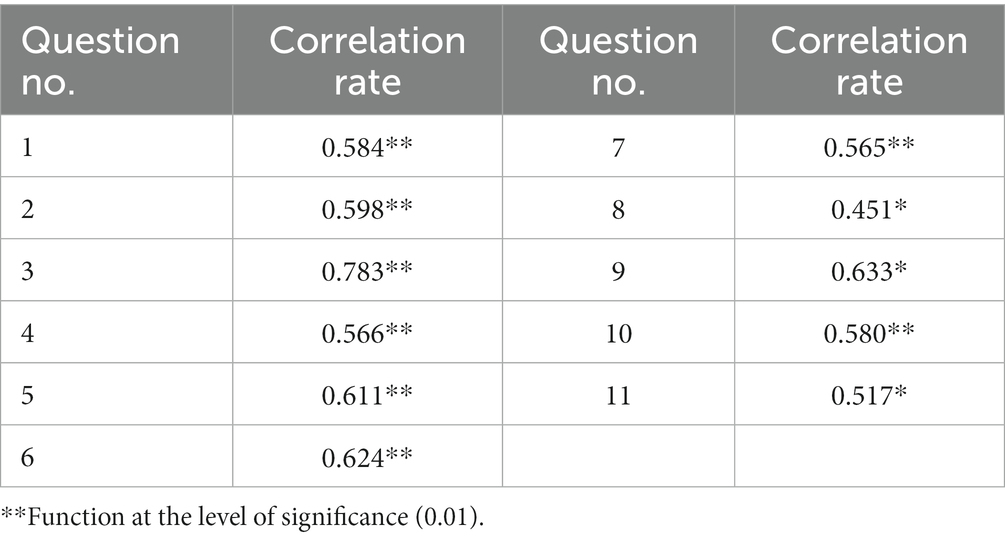
Table 1. Correlation coefficients between the questions in the first section of the questionnaire, “The reality of teaching Saudi Arabian Sign Language (SASL) to hearing students,” and the total score.
Similarly, Table 2 displays the correlation coefficients for the second section of the questionnaire. The results reveal significant positive correlations between most of the questions and the total score, suggesting that the questions in this section also contribute significantly to the overall score.
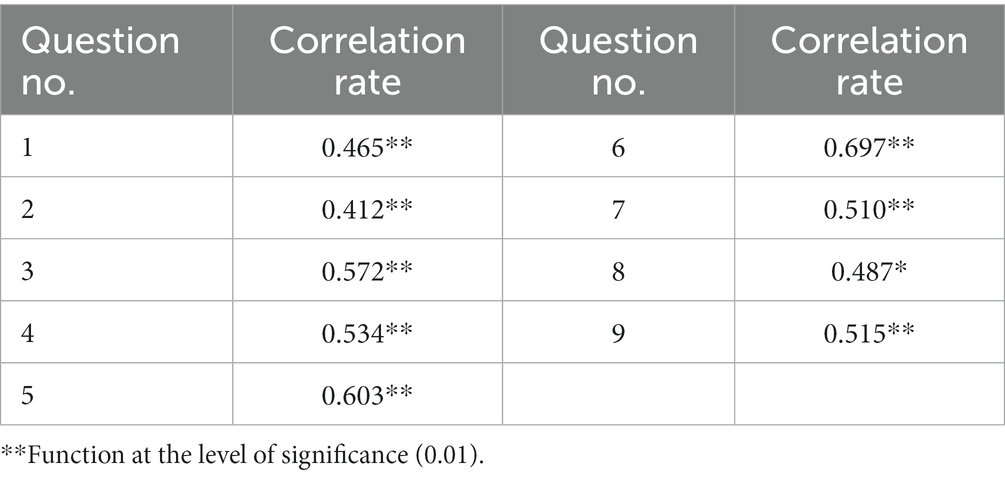
Table 2. Correlation coefficients between the questions of the second section of the questionnaire, “Obstacles to teaching SASL to hearing students,” and the total score.
Furthermore, Table 3 presents the correlation coefficients between the total score for each section of the questionnaire and the overall score for the entire questionnaire. The high correlation coefficients indicate strong associations between the individual section scores and the overall score.
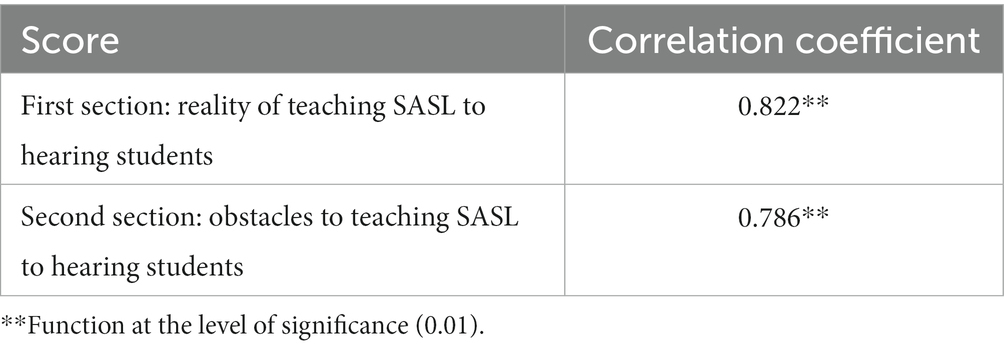
Table 3. Correlation coefficients between the total score for each section of the questionnaire and the total score for the questionnaire.
Table 4 presents the Cronbach’s alpha stability coefficients for the questionnaire sections and the questionnaire as a whole. The Cronbach’s alpha coefficient is a measure of internal consistency and indicates the stability of the study tool.
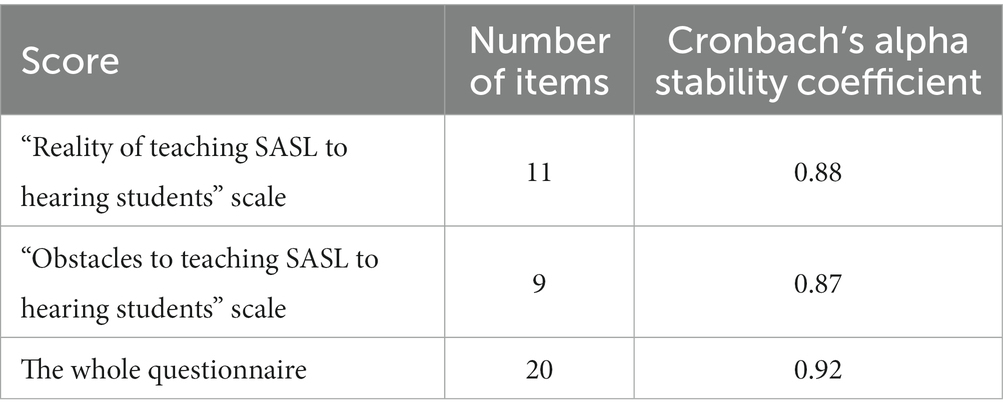
Table 4. Cronbach’s alpha stability coefficients for the questionnaire sections and the questionnaire as a whole.
In the present study, various statistical methods were utilized to comprehensively analyze the collected data. Initially, a descriptive analysis was conducted to summarize the dataset, providing essential measures such as means and standard deviations. The structural validity and internal consistency of the questionnaire were assessed using Pearson correlation coefficients and Cronbach’s alpha coefficients. Multiple regression analysis allowed the investigation of factors affecting different scale scores. ANOVA tests were employed to examine variations in responses across categories like gender and grade level. These statistical approaches collectively strengthened the study’s data analysis, providing a robust foundation for drawing meaningful conclusions.
The present study aimed to investigate the reality of teaching sign language to hearing students. To answer this research question, a descriptive analysis was conducted to analyze participants’ responses to each item in the scale. The results are presented in Table 5.
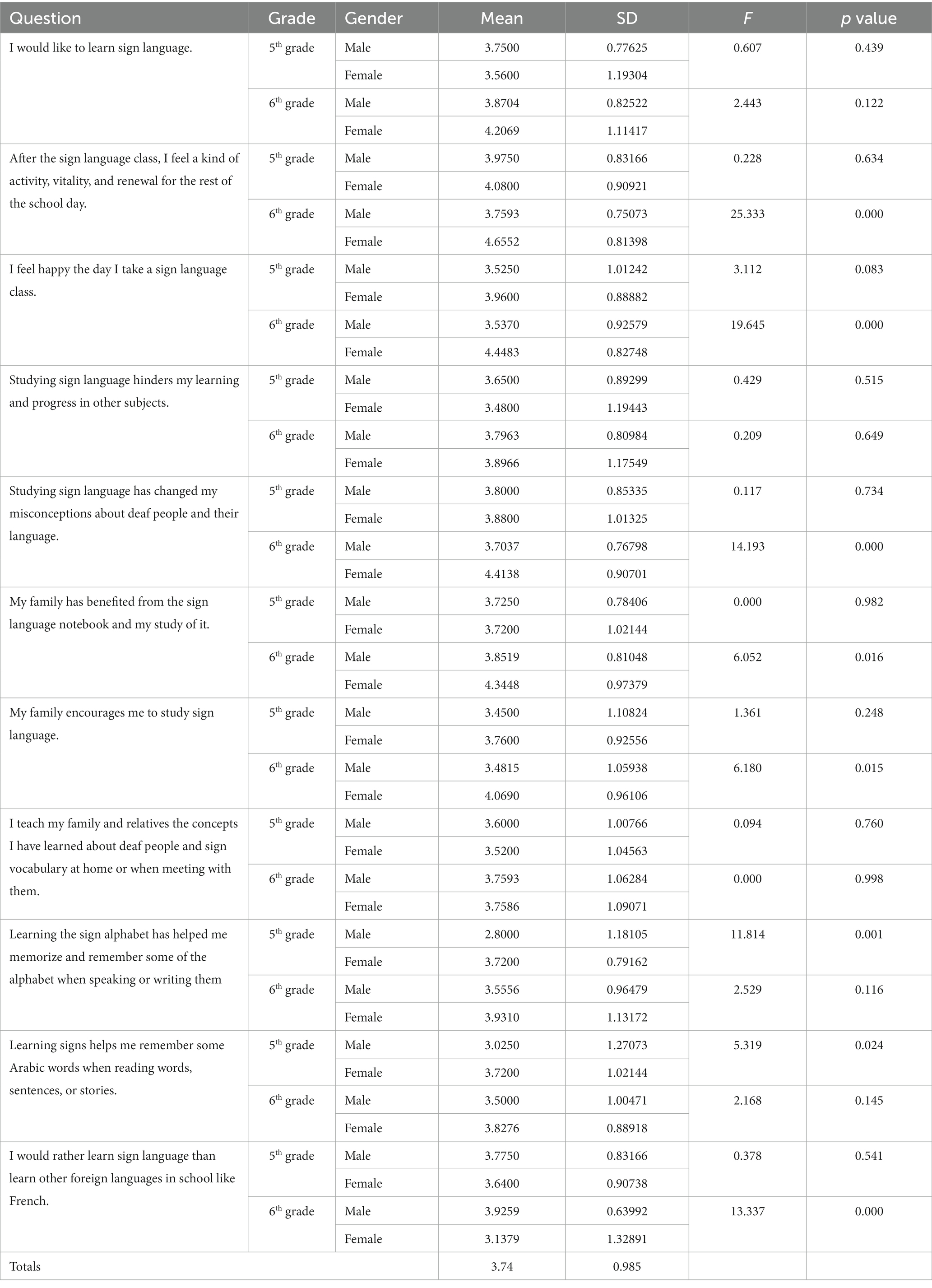
Table 5. Participants’ responses to each item of the “Reality of teaching SASL to hearing students” scale.
Upon meticulous examination of Table 5, several noteworthy findings come to light. Notably, there exists a prevailing interest in learning sign language across both grade levels and genders, as evidenced by generally positive responses. It is particularly striking that female students in the 6th grade exhibited the highest mean response (M = 4.2069), underscoring a robust desire to acquire sign language proficiency.
Moreover, the study unveiled that sign language classes have a pronounced positive impact on students’ well-being. The item “After the sign language class, I feel a kind of activity, vitality, and renewal for the rest of the school day” illuminates the invigoration experienced by female students in both 5th and 6th grades, with 6th-grade female students reporting the highest mean (M = 4.6552).
Furthermore, female students in the 6th grade (M = 4.4483) expressed higher levels of happiness on the days they had sign language classes, indicating a favorable emotional response to these educational sessions. Importantly, the study revealed that studying sign language did not significantly hinder academic progress in other subjects, as no significant differences were detected in most cases.
Crucially, the findings underscore that learning sign language has the potential to positively reshape students’ perceptions of deaf individuals and their language. Female students in the 6th grade demonstrated the highest mean response (M = 4.4138) in this regard, highlighting the transformative power of sign language education in dispelling misconceptions.
Family engagement was also a prominent theme in the study, with students widely reporting that their families were supportive and encouraging regarding their sign language studies. Additionally, the research illuminated the language learning benefits of sign language, particularly in terms of aiding memorization and retention of alphabets and words. Remarkably, in the 6th grade, male students expressed a clear preference for learning sign language over other foreign languages, with a significant difference compared to their 5th-grade counterparts, indicating a noteworthy shift in educational preferences.
Table 6 provides a comprehensive overview of the participants’ responses, offering insights into the obstacles encountered in teaching Saudi Arabian Sign Language (SASL) to hearing students, while considering variables such as grade levels and gender. Several noteworthy observations can be drawn from the data.
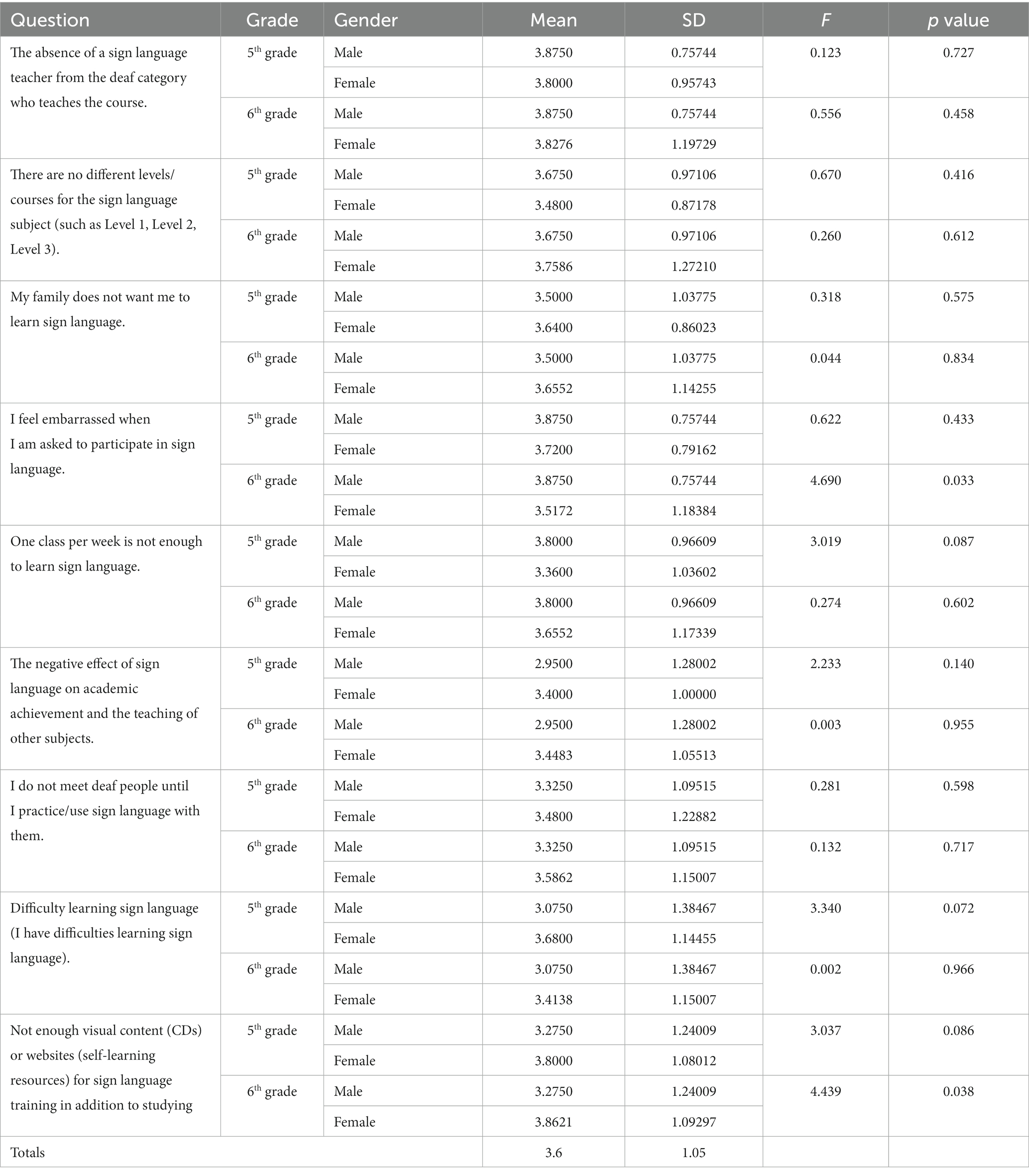
Table 6. Participants’ responses to each item of the “Obstacles to teaching SASL to hearing students” scale.
Firstly, the absence of a sign language teacher from the deaf category, responsible for teaching the course, did not emerge as a significant obstacle. This observation held true across both grade levels and genders, as evidenced by non-significant p-values.
Secondly, participants generally perceived a lack of different levels or courses available for the sign language subject. This was seen as a potential challenge to the learning process. However, it’s noteworthy that these perceptions did not yield statistically significant differences among different grade levels or genders.
Thirdly, the influence of family on the decision to learn sign language varied among participants. While some students reported resistance from their families regarding their pursuit of sign language education, this factor did not show significant differences across most groups.
Interestingly, male students in the 6th grade reported feeling embarrassed when asked to participate in sign language, and this response significantly differed from their 5th-grade counterparts. This suggests that social factors may play a role in influencing students’ willingness to engage with SASL.
Moreover, a notable finding pertains to the perceived frequency of SASL classes. While it was evident that some participants believed that one class per week might be insufficient for effective learning, this concern was more pronounced among 5th-grade male students. Although this difference did not reach statistical significance, it hints at potential concerns regarding the frequency of SASL classes.
Importantly, the negative effect of sign language on academic achievement and the teaching of other subjects did not appear to be a significant concern for most participants, as indicated by non-significant differences.
Furthermore, participants expressed a desire for more interaction with deaf individuals as part of their sign language practice. However, these feelings did not lead to statistically significant differences across grade levels and genders.
Lastly, while some students reported difficulties in learning sign language, these challenges did not show significant differences across most groups. However, it’s worth noting that the availability of visual content (CDs) or websites for self-learning resources in sign language was perceived as lacking by some students. Notably, 6th-grade male students identified this as an obstacle, and this difference was statistically significant compared to their 5th-grade counterparts.
These findings collectively shed light on the various obstacles encountered in teaching SASL to hearing students, providing valuable insights for educators and policymakers aiming to enhance the SASL learning experience and address potential challenges effectively.
Table 7 presents the outcomes of the multiple regression analysis aimed at identifying factors affecting scale scores related to the “Reality of teaching SASL to hearing students” scale, the “Obstacles to teaching SASL to hearing students” scale, and the overall scale encompassing both aspects.
In the case of the “Obstacles to Teaching SASL to Hearing Students” scale, neither gender nor grade level emerged as significant predictors of the scale scores. Both genders, with a beta coefficient of 0.024 (t = 0.291), and grade level, with a beta coefficient of 0.085 (t = 1.028), failed to exhibit statistically significant impacts on the scores.
However, when examining the overall scale, which encompasses both the reality and obstacles of teaching SASL, gender displayed a statistically significant impact. Female students, on average, scored higher on the overall scale, as indicated by a beta coefficient of 0.128 (t = 1.561, p < 0.05). This suggests that when considering both positive perceptions and obstacles, female students tended to have a more favorable view of SASL education.
Furthermore, grade level also demonstrated a significant impact on the overall scale. Students in the 6th grade, on average, tended to have higher scores on the combined scale compared to their 5th-grade counterparts, with a beta coefficient of 0.137 (t = 1.679, p < 0.05). This finding indicates that older students may have a more positive overall perception of SASL instruction, encompassing both the benefits and challenges associated with it.
The study’s findings provide valuable insights into students’ attitudes and perceptions regarding the learning of Saudi Arabian Sign Language (SASL). Overall, participants displayed a positive outlook on learning sign language, indicating a strong desire to acquire this skill. Of particular note is the positive impact of SASL classes on students’ well-being, as evidenced by increased vitality and happiness after attending these classes.
Additionally, the study highlights SASL’s potential to challenge and alter misconceptions about deaf individuals and their language. The positive influence of sign language education on students’ families is also significant, suggesting that SASL can facilitate communication and understanding within households.
Nuanced differences were observed between grade levels and genders. Older students, especially 6th-grade females, exhibited more favorable attitudes, implying that age and maturity may shape perceptions of sign language.
The preference for learning sign language over other foreign languages among 6th-grade students suggests that students recognize the practical value of SASL education. This finding has implications for curriculum development and educational policies that promote SASL as a valuable skill for students.
The insights from Table 6 shed light on the obstacles encountered when teaching Saudi Arabian Sign Language (SASL) to hearing students.
The absence of a sign language teacher did not emerge as a significant obstacle. While participants expressed concerns about the lack of different SASL levels, these concerns did not significantly differ across grade levels and genders.
Family influence on SASL learning showed varying perceptions. Significant differences were observed among 6th-grade male students regarding embarrassment in participating in SASL classes. Perceptions about the frequency of SASL classes, especially among 5th-grade male students, indicate the need for a review of class frequency and duration.
Non-significant findings regarding the negative effect of SASL on academic achievement align with previous research emphasizing the overall positive correlation between sign language education and academic performance.
Participants’ desire for more interaction with deaf individuals underscores the need to incorporate practical opportunities for real-life SASL practice and engagement with the deaf community into the curriculum. Non-significant differences in reported difficulties in learning SASL suggest that, in general, students do not find SASL significantly more challenging than other subjects.
The significant concern raised by 6th-grade male students regarding the lack of visual content for self-learning resources emphasizes the importance of accessible and engaging SASL materials beyond the classroom.
The results of the multiple regression analysis shed light on the factors influencing students’ perceptions regarding the reality of teaching SASL to hearing students, the obstacles involved, and the overall scale encompassing both aspects.
For the reality of teaching SASL to hearing students, gender significantly affected perceptions. Grade level also had an impact, suggesting that 6th-grade students may be more receptive to SASL instruction or may have had more exposure to the subject.
Interestingly, neither gender nor grade level significantly affected the perception of obstacles to teaching SASL. This might imply that challenges related to SASL education are relatively consistent, emphasizing the need for comprehensive strategies to address these challenges.
Based on the study’s findings, several recommendations can be proposed:
Tailored Curriculum Development: Given the positive attitudes toward SASL, especially among older and 6th-grade female students, educational institutions should consider tailoring the curriculum to further enhance the SASL learning experience. This could involve offering advanced levels or specialized courses to meet varying student interests and needs.
Enhanced Teacher Training: Despite the absence of a significant obstacle related to the lack of a sign language teacher, there’s a need for specialized training programs for teachers. The aim is to ensure that educators possess comprehensive skills and knowledge in SASL teaching methodologies, catering to diverse student requirements.
Revision of Class Frequency and Content: Addressing concerns regarding class frequency and content, especially as expressed by 5th-grade male students, warrants a reevaluation of SASL course structures. Schools could consider adjusting class schedules or incorporating more engaging visual content to optimize the learning experience.
Real-life Practice and Engagement: Acknowledging students’ desire for increased interaction with the deaf community, educators should integrate practical opportunities for real-life SASL practice and engagement. This could involve community involvement programs or activities fostering direct interaction with deaf individuals to enhance language acquisition.
Diverse and Accessible Learning Resources: To cater to the preferences of 6th-grade male students for visual content in self-learning resources, there’s a need for the development of diverse and accessible materials beyond the classroom setting. Creating engaging SASL resources, particularly with visual components, could aid independent learning.
Comprehensive Approach to Address Challenges: As neither gender nor grade level significantly affected the perception of obstacles to teaching SASL, it emphasizes the necessity for a comprehensive approach. Institutions should devise multifaceted strategies encompassing varied teaching methodologies and support systems to address consistent challenges in SASL education.
These recommendations aim to capitalize on the study’s insights and address nuanced aspects identified in students’ attitudes, obstacles, and perceptions toward SASL learning and teaching.
In conclusion, this research study delved into the critical aspects of teaching Saudi Arabian Sign Language (SASL) to hearing students in Saudi Arabia. The study unveiled several key findings. Firstly, it was evident that there exists a substantial interest among students, particularly females and those in the 6th grade, to learn SASL, showcasing the potential for its widespread adoption as an additional language skill.
Moreover, the study highlighted the positive impact of SASL on students’ well-being, happiness, and family dynamics. It emerged that learning SASL had a transformative effect on students’ perceptions of the deaf community and its language, breaking down misconceptions and fostering inclusivity. This finding underscores the broader societal benefits of promoting SASL education.
However, the research also identified obstacles and challenges. These included the absence of qualified SASL teachers and limited course levels, emphasizing the need for dedicated teacher training programs and curriculum development. Additionally, there were concerns about the adequacy of classroom time devoted to SASL instruction and the potential negative impact on academic progress. These challenges must be addressed to ensure the effectiveness and integration of SASL education.
The multiple regression analysis shed light on the factors affecting students’ perceptions of SASL education, with gender and grade level showing notable influences. This insight can guide educational policymakers and practitioners in tailoring SASL programs to specific student demographics.
In light of these findings, a set of recommendations has been proposed, encompassing the preparation of SASL teachers, increased involvement of deaf instructors, enriched learning resources, and expanded SASL curricula. These recommendations aim to foster a more inclusive educational environment, where SASL can be embraced as a valuable means of communication.
The raw data supporting the conclusions of this article will be made available by the authors, without undue reservation.
The studies involving humans were approved by Scientific Research Ethics Committee at Sattam Bin Abdulaziz University. The studies were conducted in accordance with the local legislation and institutional requirements. Written informed consent for participation in this study was provided by the participants' legal guardians/next of kin.
The author is solely responsible for Conceptualization, Data curation, Formal analysis, Funding acquisition, Investigation, Methodology, Project administration, Resources, Software, Supervision, Validation, Visualization, Writing – original draft, Writing – review & editing.
The author extends his appreciation to Prince Sattam Bin Abdulaziz University for funding this research work through the project number (PSAU/2022/02/21893).
The author would like to express heartfelt gratitude to Alshams Private School in Riyadh, Saudi Arabia, for graciously providing the platform and facilities to conduct this study. The support and cooperation extended by the school’s administration and staff were invaluable in the successful completion of this research. Special thanks are extended to the students of Alshams Private School who wholeheartedly participated in this study. Their active involvement and willingness to contribute to the research significantly enriched the findings. Lastly, the author expresses appreciation to all the advisors and reviewers who provided their valuable guidance and feedback in evaluating the study instrument, ensuring its methodological rigor.
The author declares that the research was conducted in the absence of any commercial or financial relationships that could be construed as a potential conflict of interest.
All claims expressed in this article are solely those of the authors and do not necessarily represent those of their affiliated organizations, or those of the publisher, the editors and the reviewers. Any product that may be evaluated in this article, or claim that may be made by its manufacturer, is not guaranteed or endorsed by the publisher.
Abdulrahman, S. (2017). Obstacles to higher education for deaf and hard of hearing students: diagnosis, proposed solutions and recommendations. J. Educ. Technol. 3, 241–258. Available at: https://search.mandumah.com/Record/876017
Alamri, A. (2009). Competencies required for sign language interpreters from the point of view of the deaf and sign language interpreters in the Kingdom of Saudi Arabia. Unpublished master’s thesis. King Saud University, Riyadh.
Alamri, A. (2017). Saudi sign language interpreters: their attitudes towards professional sign language interpretation. Unpublished doctoral dissertation. Lamar University, Beaumont. Available at: https://www.proquest.com/openview/72e9baa0392af1e94083f46f510711db/1?pq-origsite=gscholar&cbl=18750.
Alamri, G. (2017). Teachers’ beliefs and attitudes about Saudi Arabia sign language. Lamar University, Beaumont. Available at: https://www.proquest.com/openview/e6befad0e3239c71f953becd52f07984/1?pq-origsite=gscholar&cbl=18750.
Alamri, A. (2019). Note of introduction to Saudi Arabia sign language. College of Education, Prince Sattam bin Abdulaziz University, Alkharj.
Alamri, T., and Alrayes, T. (2021). Sign language skills of interpreters in the Kingdom of Saudi Arabia. Arab J. Gifted Sci. 5, 205–220. doi: 10.21608/jasht.2021.161847
Alrayes, T. (2007). Sign language and visual media. A realistic vision: a working paper presented to the seventh meeting of the Gulf disability association: Media and disability – an interactive relationship and mutual responsibility, Kingdom of Bahrain.
Alrayes, T., and Alamri, A. (2014). Competencies required for sign-language interpreters from the point of view of the deaf and interpreters in the Kingdom of Saudi Arabia. J. Educ. Kuwait 28, 279–324. doi: 10.34120/0085-028-111-007
Alsuraisri, N., and Alkhudair, A. A. (2019). The historical origins of the Saudi sign language and its development factors: an ethnographic study. Saudi J. Spec. Educ. 10, 43–68. Available at: https://sjse.ksu.edu.sa/sites/sjse.ksu.edu.sa/files/imce_images/ldd_10.pdf
Arab Technical News Portal (2015). Dictionary for teaching sign language in English. Available at: https://rb.gy/b25qwt
Clark, M. D., and Lee, C. M. (2018). Culture in L2/ln sign language pedagogy. Creat. Educ. 9, 1897–1909. doi: 10.4236/ce.2018.913139
McKee, R. L., and McKee, D. (1992). What’s so hard about learning ASL? Students’ & teachers’ perceptions. Sign Lang. Stud. 1075, 129–157. doi: 10.1353/sls.1992.0000
Pirone, J. S., Pudans-Smith, K. K., Ivy, T., and Listman, J. D. (2023). The landscape of American sign language education. Foreign Lang. Ann. 56, 238–258. doi: 10.1111/flan.12679
Quinto-Pozos, D. (2011). Teaching American sign language to hearing adult learners. Annu. Rev. Appl. Linguist. 31, 137–158. doi: 10.1017/S0267190511000195
Richardson, K. (2017). New evidence for early modern ottoman Arabic and Turkish sign systems. Sign Lang. Stud. 17, 172–192. doi: 10.1353/sls.2017.0001
Robinson, O., and Henner, J. (2018). Authentic voices, authentic encounters: cripping the university through American sign language. Disabil. Stud. Q. 38, 1–20. doi: 10.18061/dsq.v38i4.6111
Rosen, R. S. (2008). American sign language as a foreign language in U. S. High schools: state of the art. Mod. Lang. J. 92, 10–38. doi: 10.1111/j.1540-4781.2008.00684.x
Rosen, R. S. (2010). American Sign Language curricula: a review. Sign Lang. Stud. 10, 348–381. doi: 10.1353/sls.0.0050
Saudi Human Resources Development Fund (2017). Accommodation services for deaf and hearing impaired persons (1st edition). Tawafuq, Riyadh. Available at: https://www.hrdf.org.sa/media/Tawafuq/Content/documents/Disability-Confidence/300317_Hearing_Final_AR.pdf
Keywords: sign language, Saudi Arabian Sign Language, teaching sign language, obstacles, hearing students, inclusive education
Citation: Alamri AA (2024) The reality and obstacles of teaching Saudi Arabian Sign Language (SASL) to hearing students in regular schools: Alshams Private School as a model. Front. Educ. 9:1245983. doi: 10.3389/feduc.2024.1245983
Received: 24 June 2023; Accepted: 19 January 2024;
Published: 05 February 2024.
Edited by:
M. Diane Clark, Lamar University, United StatesReviewed by:
Zanthia Smith, Lamar University, United StatesCopyright © 2024 Alamri. This is an open-access article distributed under the terms of the Creative Commons Attribution License (CC BY). The use, distribution or reproduction in other forums is permitted, provided the original author(s) and the copyright owner(s) are credited and that the original publication in this journal is cited, in accordance with accepted academic practice. No use, distribution or reproduction is permitted which does not comply with these terms.
*Correspondence: Abdulhadi A. Alamri, YWIuYWxhbXJpQHBzYXUuZWR1LnNh
Disclaimer: All claims expressed in this article are solely those of the authors and do not necessarily represent those of their affiliated organizations, or those of the publisher, the editors and the reviewers. Any product that may be evaluated in this article or claim that may be made by its manufacturer is not guaranteed or endorsed by the publisher.
Research integrity at Frontiers

Learn more about the work of our research integrity team to safeguard the quality of each article we publish.